There’s something truly magical about homemade bread, and when it comes to elevating this simple staple, few combinations can compete with the bold flavors of rosemary and garlic. Rosemary Garlic Focaccia is not just a feast for the palate; it’s a sensory experience that fills your kitchen with an irresistible aroma, enticing everyone to gather around the table. Whether you’re a seasoned baker or a novice in the kitchen, this focaccia recipe will guide you through each step, ensuring that you create a delightful loaf that’s perfect for any occasion.
“`html
| Feature | Details |
|---|---|
| Type of Bread | Focaccia |
| Main Ingredients | Rosemary, Garlic, Flour, Water, Yeast, Olive Oil |
| Preparation Time | Approximately 2 hours (including rising time) |
| Baking Temperature | 425°F (220°C) |
| Serving Suggestions | Great as an appetizer, side dish, or sandwich base |
| Texture | Crispy on the outside, soft and airy on the inside |
| Storage | Best consumed fresh; can be stored in an airtight container |
“`
What is Focaccia?
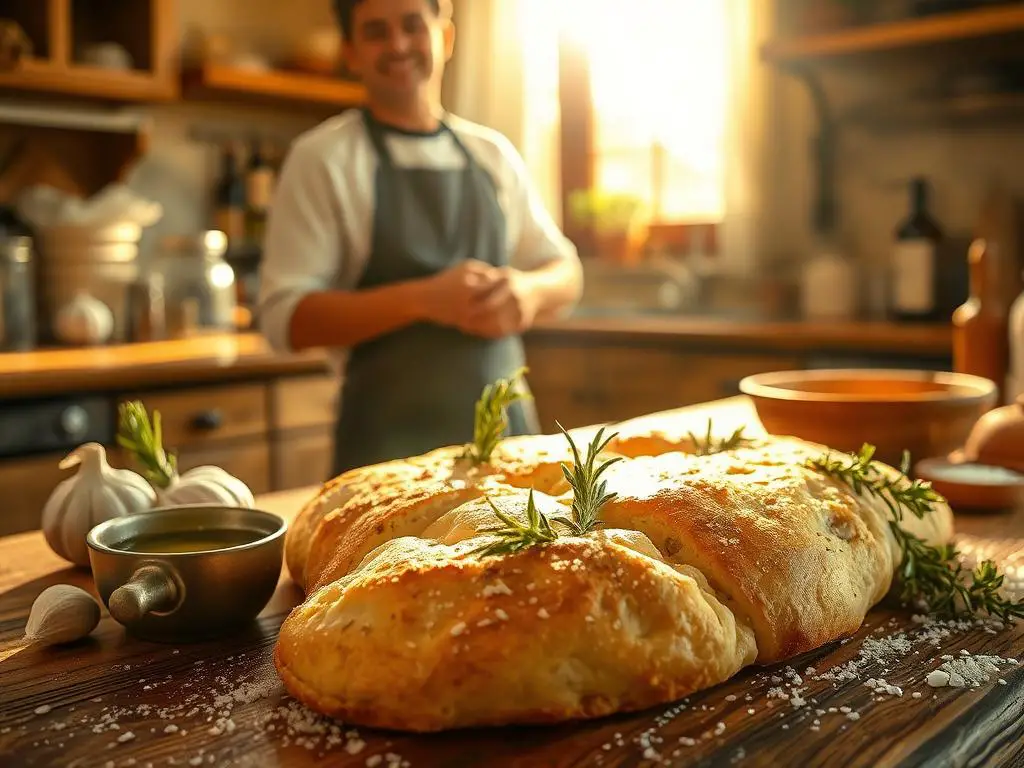
Focaccia is an Italian flatbread that is known for its soft, airy texture and a rich, flavorful crust. Traditionally, it is seasoned with olive oil, salt, and various toppings, making it versatile enough to be enjoyed on its own, as a side dish, or even as a base for sandwiches. Its origins can be traced back to ancient Rome, where it was often baked on the hearth and flavored with herbs and spices. Today, focaccia has evolved into countless variations, with rosemary and garlic being one of the most beloved combinations.
The beauty of making focaccia at home lies in the simplicity of the ingredients and the process. With just a handful of pantry staples, you can create a bread that is not only delicious but also visually appealing. The golden crust, dotted with fragrant rosemary and glistening with olive oil, is as satisfying to look at as it is to eat. So, roll up your sleeves, and let’s dive into the world of homemade Rosemary Garlic Focaccia!
Ingredients You Will Need
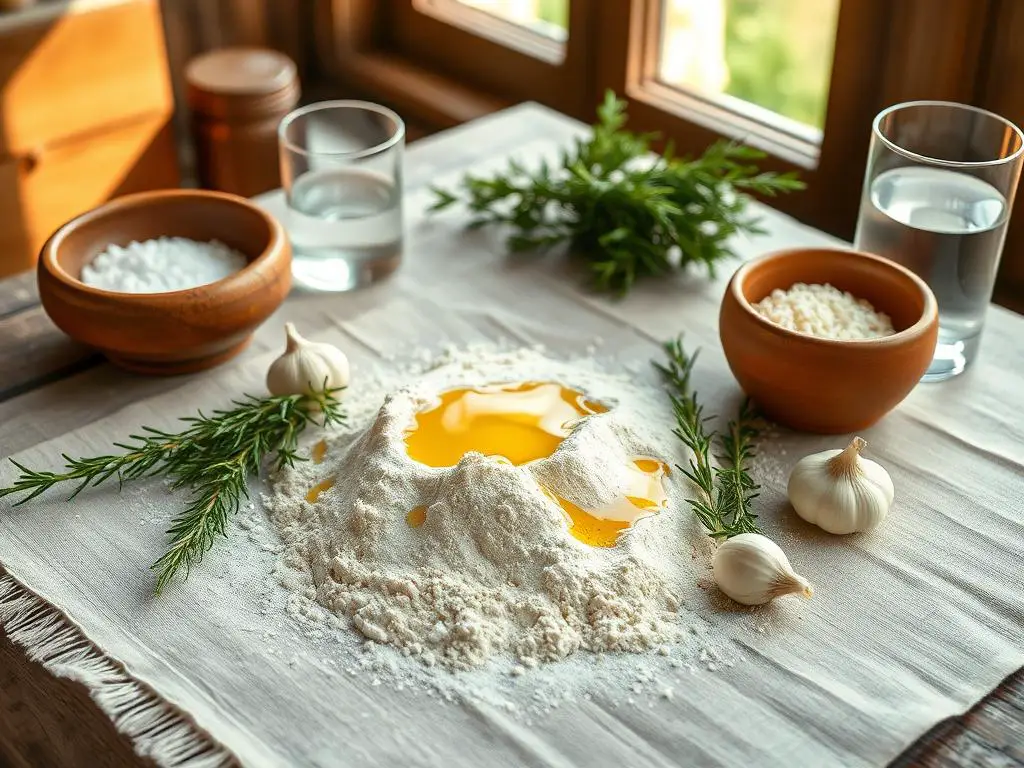
To create this aromatic focaccia, you’ll need the following ingredients:
- Flour: 4 cups of all-purpose flour is ideal for a soft and chewy texture.
- Yeast: 2 teaspoons of active dry yeast will help the dough rise.
- Water: 1 ½ cups of warm water (about 110°F) to activate the yeast.
- Olive Oil: ½ cup of high-quality extra virgin olive oil enhances the flavor and adds moisture.
- Salt: 2 teaspoons of kosher salt for seasoning the dough and the topping.
- Garlic: 4-6 cloves, minced or thinly sliced, to infuse the bread with rich flavor.
- Rosemary: 2-3 sprigs of fresh rosemary, leaves stripped and chopped, to give that signature herbal note.
- Coarse Sea Salt: For sprinkling on top before baking, adding a delightful crunch.
Step-by-Step Instructions
Now that you have gathered all your ingredients, let’s walk through the process of making Rosemary Garlic Focaccia from scratch. Follow these steps for a foolproof recipe that will have your family and friends begging for seconds!
Step 1: Prepare the Dough
In a large mixing bowl, combine the warm water and yeast. Allow it to sit for about 5-10 minutes, or until it becomes frothy. This step is crucial as it activates the yeast, ensuring your bread rises properly.
Next, add the flour, olive oil, salt, minced garlic, and chopped rosemary to the yeast mixture. Stir with a wooden spoon or spatula until the dough begins to come together. It may be slightly sticky, but that’s perfectly normal!
Step 2: Knead the Dough
Transfer the dough onto a lightly floured surface and knead it for about 5-7 minutes. You want the dough to be smooth and elastic. If it’s too sticky, sprinkle a little more flour as needed. Once your dough has reached the right consistency, form it into a ball.
Step 3: First Rise
Place the dough in a lightly oiled bowl, cover it with a clean kitchen towel or plastic wrap, and let it rise in a warm, draft-free area for about 1-2 hours, or until it has doubled in size. This step is vital for developing the bread’s flavor and texture.
Step 4: Prepare the Baking Pan
While the dough is rising, prepare your baking pan. You can use a half-sheet pan or a 9×13 inch baking dish. Generously drizzle olive oil across the bottom of the pan, making sure to coat it well. This will help create that crispy crust we all love.
Step 5: Shape the Dough
Once the dough has risen, gently punch it down to release any air bubbles. Transfer it to the prepared baking pan and use your fingers to stretch it out to fit the pan. If the dough resists, let it rest for a few minutes before continuing to stretch it.
Now that you’ve shaped the dough, it’s time for the second rise. Cover the pan again and let it rise for another 20-30 minutes. During this time, preheat your oven to 425°F (220°C).
Final Touches Before Baking
Before sliding your focaccia into the oven, drizzle a bit more olive oil on top and use your fingers to create dimples all over the surface of the dough. Sprinkle coarse sea salt and additional rosemary leaves for an extra punch of flavor. This not only enhances the visual appeal but also ensures that each bite is packed with flavor.
Once you’re satisfied with the look of your focaccia, it’s time to bake! Stay tuned for the next section, where we’ll cover the final baking process and how to serve this delightful Rosemary Garlic Focaccia.
Baking Your Rosemary Garlic Focaccia
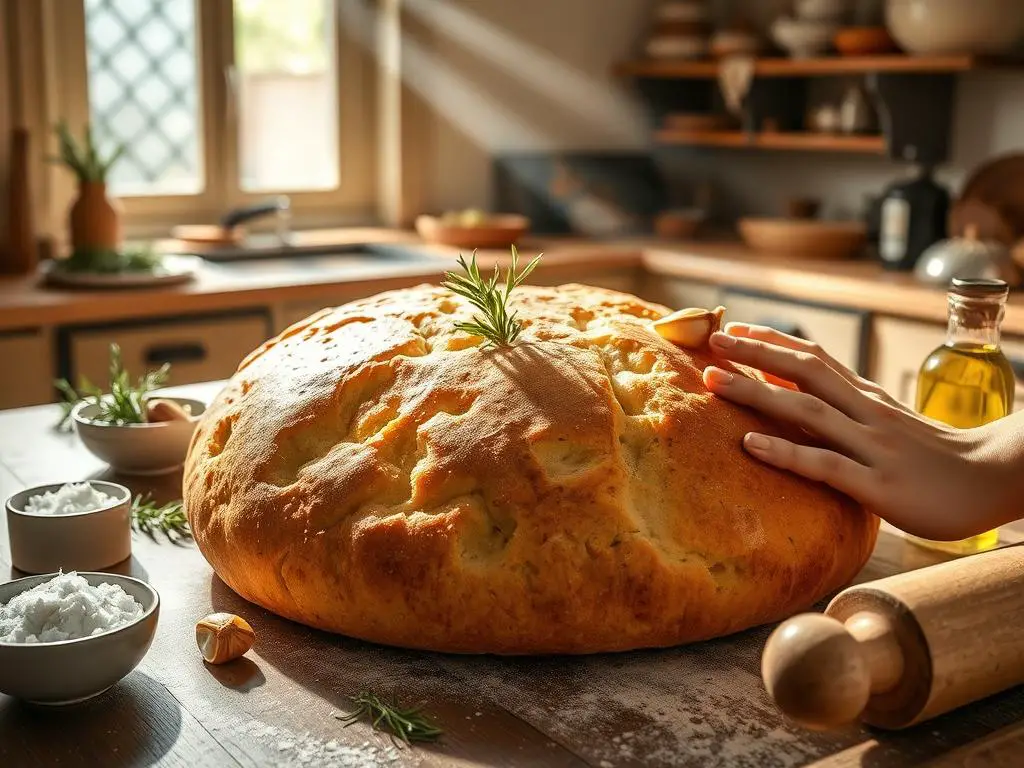
With your focaccia shaped and ready, it’s time to let the oven work its magic. Baking is the moment when all the hard work and delicious ingredients come together to create a delightful loaf that will impress anyone who lays eyes (and taste buds) on it. Here’s how to ensure your focaccia comes out perfectly golden and aromatic.
Step 6: Bake the Focaccia
Carefully place your baking pan into the preheated oven at 425°F (220°C). Bake the focaccia for about 20-25 minutes, or until the top is a beautiful golden brown and the edges are crisp. The aroma of rosemary and garlic will fill your kitchen, making it hard to resist sneaking a piece before it’s even cool. To check for doneness, gently tap the bottom of the bread; it should sound hollow when fully baked.
Keep an eye on it towards the end of the baking time. Ovens can vary in temperature, so you want to catch it just at the right moment for that perfect crust without burning. If it’s browning too quickly, you can cover it loosely with aluminum foil for the last few minutes of baking.
Step 7: Cool and Slice
Once baked, remove the focaccia from the oven and allow it to cool in the pan for about 10 minutes. This resting period lets the steam escape, helping the crust to maintain its texture. After cooling, transfer the focaccia to a wire rack to cool completely. This step is important because cooling it on a rack prevents the bottom from becoming soggy.
Once cooled, slice the focaccia into squares or triangles, depending on your preference. Use a serrated knife for clean cuts, and be gentle to maintain the airy structure of the bread.
Serving Suggestions
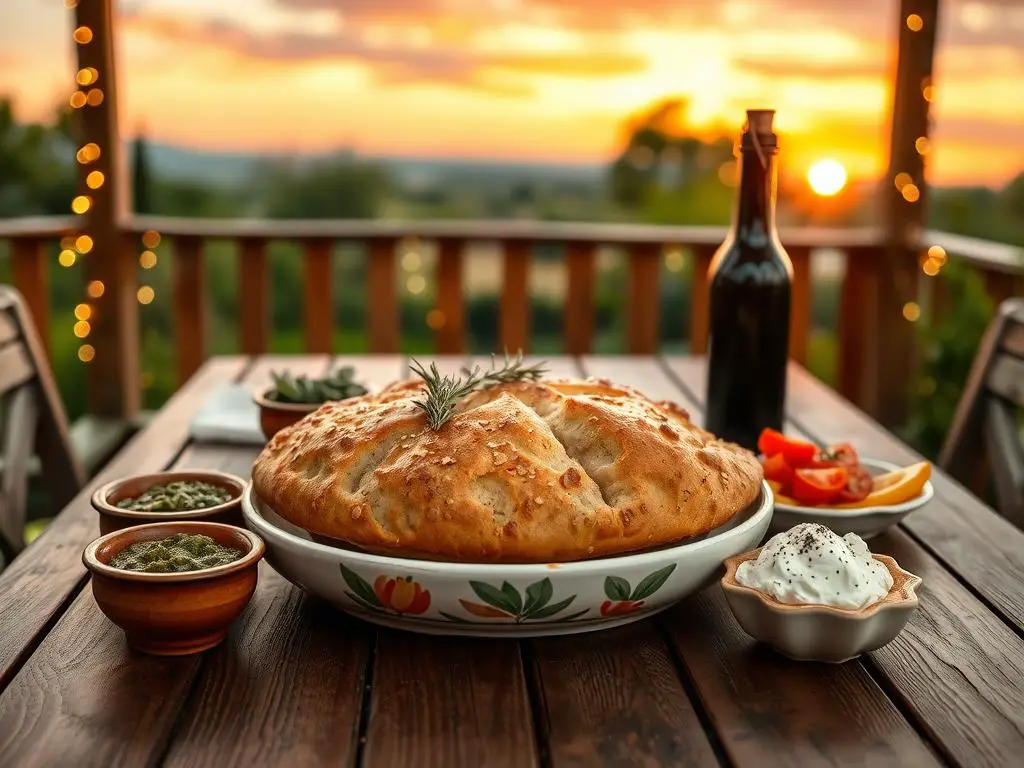
Now that you have your beautiful Rosemary Garlic Focaccia ready, it’s time to think about how to serve it. This bread is incredibly versatile and can be enjoyed in numerous ways:
- As an Appetizer: Serve warm focaccia alongside a bowl of olive oil and balsamic vinegar for dipping. You can also add some freshly cracked pepper or a sprinkle of herbs to the oil for a gourmet touch.
- With Soups and Salads: Focaccia makes an excellent accompaniment to hearty soups and fresh salads. Its texture is perfect for soaking up delicious broth or dressing.
- As a Sandwich Base: Use slices of focaccia to create scrumptious sandwiches. Layer it with your favorite meats, cheeses, and fresh vegetables for a delicious meal.
- For Breakfast: Toast slices of focaccia and spread them with butter or jam for a delightful morning treat.
- For Snacking: Enjoy focaccia on its own as a snack, or top it with spreads like hummus or pesto for a flavorful bite.
Storing Your Focaccia
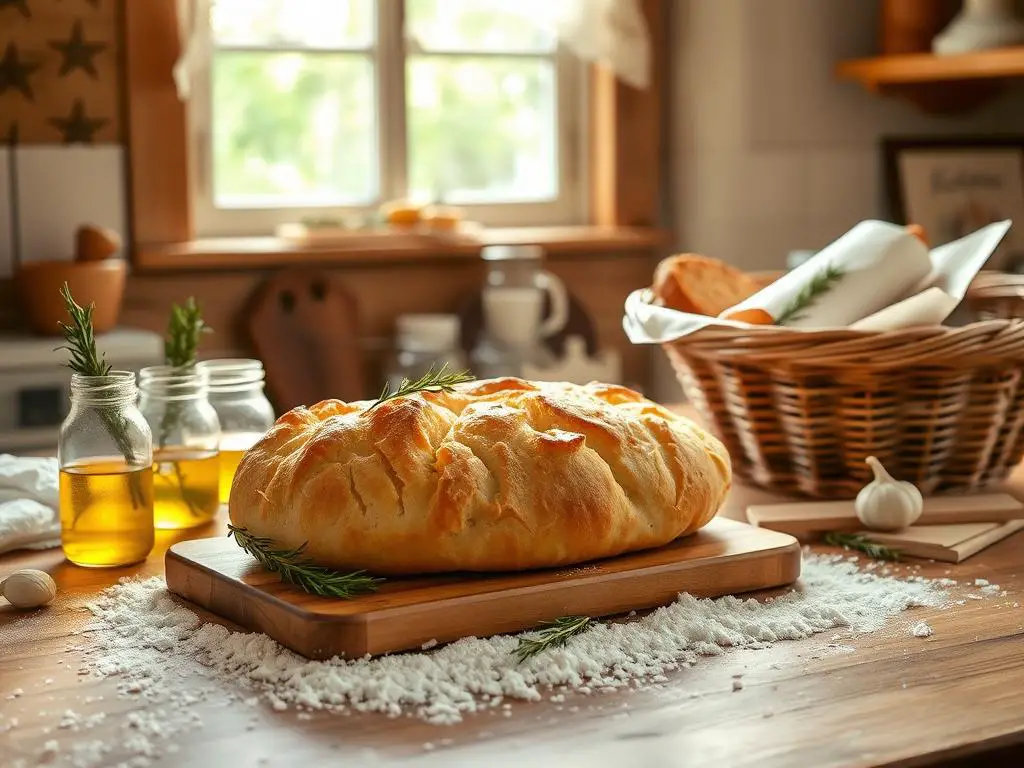
If you find yourself with leftover focaccia (which can be a rarity!), it’s important to know how to store it. To maintain its freshness, wrap the focaccia in plastic wrap or aluminum foil and place it in an airtight container. It can be stored at room temperature for up to 2 days. If you want to keep it longer, you can freeze it. Just make sure to slice it before freezing, so you can take out individual pieces as needed.
To reheat, simply place the focaccia in a preheated oven at 350°F (175°C) for about 10-15 minutes until warmed through. This will help restore the crust’s crispness.
Experimenting with Flavors
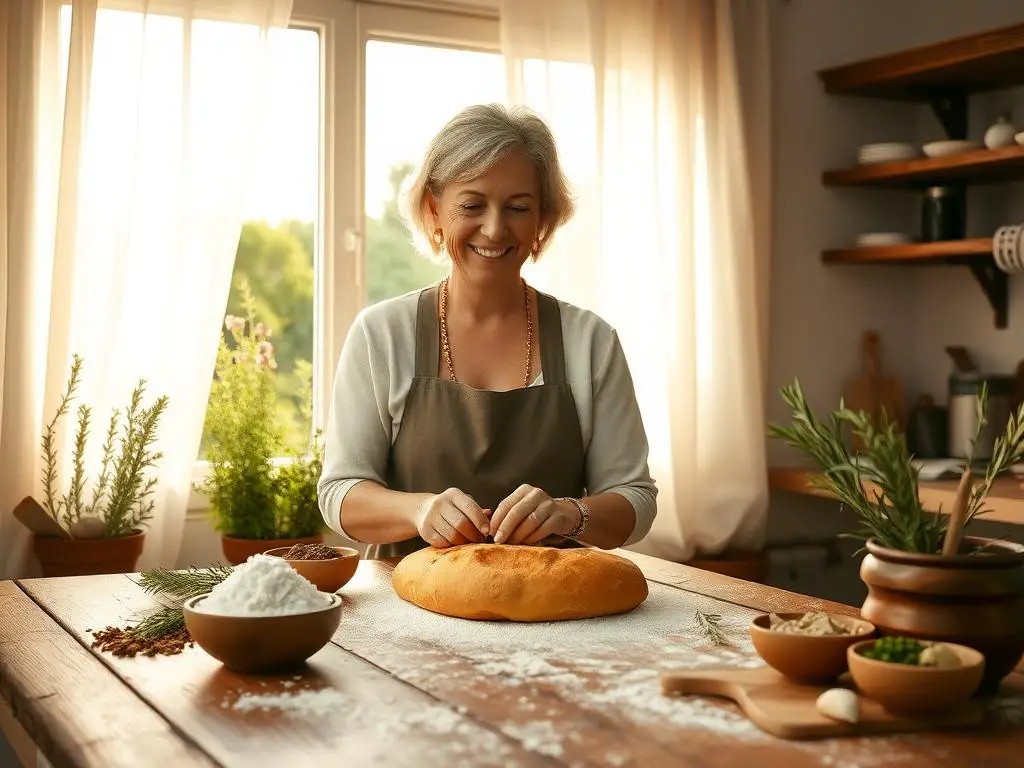
Once you’ve mastered the classic Rosemary Garlic Focaccia, feel free to experiment with flavors! The beauty of focaccia lies in its versatility. Here are some ideas to inspire your creativity:
- Herbed Focaccia: Try adding different herbs like thyme, basil, or oregano to the dough or as toppings.
- Cheese-Stuffed Focaccia: Incorporate shredded Parmesan or mozzarella cheese into the dough or sprinkle it on top before baking for a cheesy crust.
- Vegetable Toppings: Top your focaccia with sliced tomatoes, olives, or caramelized onions for added flavor and texture.
- Sweet Variations: Try a sweet focaccia by adding honey and rosemary or topping it with fruit before baking for a unique dessert.
With these suggestions in mind, you can create a focaccia that’s uniquely yours, perfect for any occasion or simply to enjoy at home. Happy baking!
Pairing Your Focaccia with Drinks
When it comes to enjoying your Rosemary Garlic Focaccia, pairing it with the right beverages can elevate your experience even further. Whether you’re hosting a dinner party or enjoying a casual meal at home, consider these drink options that complement the flavors of this delicious bread:
- Wine: A light, crisp white wine such as Sauvignon Blanc or Pinot Grigio pairs beautifully with focaccia. The acidity of these wines balances the richness of the olive oil and the savory notes from the garlic and rosemary. For red wine lovers, a light-bodied Chianti or a Grenache can also enhance the flavors without overpowering them.
- Craft Beer: If you prefer beer, opt for a pale ale or a pilsner. These styles offer refreshing notes that can cut through the richness of the focaccia while complementing its texture. A wheat beer with citrus undertones might also work well, especially if you add lemon zest to your focaccia toppings.
- Herbal Tea: For a non-alcoholic option, consider serving herbal teas such as chamomile or mint. Their natural flavors can create a lovely contrast to the savory focaccia, providing a refreshing palate cleanser between bites.
- Sparkling Water: A fizzy drink like sparkling water or flavored seltzer can also be a great accompaniment. The effervescence will cleanse your palate, enhancing the overall taste of your meal.
Creative Ways to Use Focaccia in Meals
Beyond serving focaccia on its own or as a side, there are numerous inventive ways to incorporate this bread into your meals. Here are some delicious ideas:
- Focaccia Pizza: Transform your focaccia into a quick and easy pizza. Simply spread a layer of tomato sauce, sprinkle your favorite cheeses, and add toppings like pepperoni, bell peppers, or spinach. Bake it in the oven until the cheese is melted and bubbly for a delightful twist on traditional pizza.
- Focaccia Croutons: For an interesting salad addition, cut leftover focaccia into cubes, toss them in olive oil, and season with garlic powder or herbs. Bake until golden and crispy for croutons that will add a wonderful texture to any salad.
- Bruschetta Base: Use slices of focaccia as a base for bruschetta. Top them with diced tomatoes, basil, balsamic glaze, and a sprinkle of salt for an appetizer that’s bursting with flavor.
- Focaccia Sandwiches: The sturdy yet soft texture of focaccia makes it perfect for sandwiches. Layer it with roasted vegetables, grilled chicken, or turkey along with fresh greens and spreads like pesto or aioli for a quick, satisfying meal.
Focaccia Variations Around the World
While Rosemary Garlic Focaccia is a classic, various cultures have their own versions of flatbreads that share similarities. Exploring these variations can enhance your appreciation for this versatile bread. Here are a few noteworthy examples:
- Turkish Pide: Often referred to as Turkish flatbread, pide is shaped like a boat and topped with ingredients like ground meat, cheese, and vegetables. It is baked until crispy and served hot, making it a popular street food.
- Indian Naan: Naan is a leavened flatbread typically cooked in a tandoor (clay oven). It’s often flavored with garlic, herbs, or stuffed with fillings like cheese or spiced potatoes. Naan serves as an excellent accompaniment to curries and other Indian dishes.
- Greek Pita: Pita bread is a round flatbread that puffs up when baked, creating a pocket that can be filled with various ingredients. It’s commonly used for gyros and falafel and can be enjoyed warm or toasted.
- Middle Eastern Lavash: This thin flatbread is often served with dips like hummus or baba ghanoush. It can be rolled or folded around fillings, making it a versatile option for wraps and sandwiches.
The Science Behind Bread Baking
Understanding the science behind bread baking can help you become a more confident baker and improve your focaccia-making skills. Here are some key concepts to keep in mind:
- Yeast Activation: Yeast is a living organism that ferments sugars in the dough, producing carbon dioxide and alcohol. This process creates air pockets in the dough, leading to a light and airy bread. Ensuring your yeast is fresh and activating it properly is crucial for successful bread.
- Gluten Development: Gluten, a protein found in wheat, gives bread its structure and elasticity. Kneading the dough helps develop gluten, allowing it to stretch and trap the gases produced by yeast. This is why kneading is an essential step in making focaccia.
- Hydration Levels: The amount of water in your dough affects its texture. Higher hydration levels lead to a more open crumb, while lower hydration results in a denser loaf. Experimenting with different hydration levels can lead to varying results in your focaccia.
- Baking Temperature: Baking at the right temperature is vital for achieving the perfect crust. Too low a temperature can result in a pale loaf, while too high can burn the outside before the inside is fully cooked. Understanding your oven’s quirks can be beneficial.
By applying these principles, you can troubleshoot any baking challenges you encounter and create focaccia that consistently impresses.
